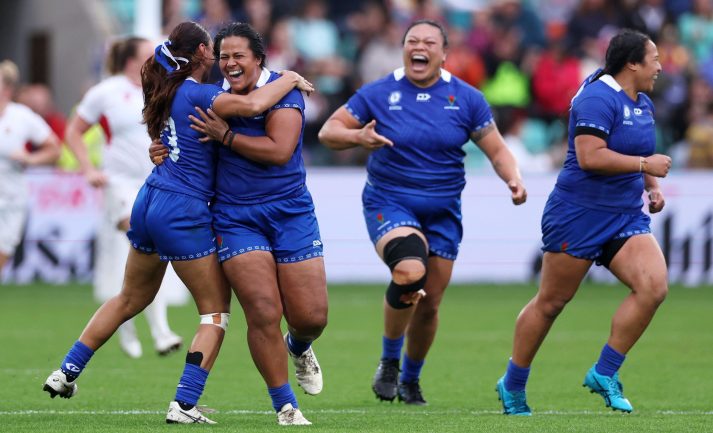The filling in the sandwich
This was the Big Show, big crowds, painted faces, all the fun of the fair.
You’ll recall Gaelle Mignot screaming at her troops: “Six weeks, six weeks!” Looking forward, they looked like an eternity. Looking back, they were gone in the blink of an eye.
There were three pool rounds to come first. If people were hoping for a giant-killing act, it seemed unlikely. Each pool of four was divided strictly according to rankings. The only possible upsets might come where two nations were relatively closely placed in merit.
That’s how it turned out on the first weekend. Italy held France to a modest 24-0 win.
In the second round we had extremes. England put 92 points on Samoa, but before doubters could pour scorn on such an unequal contest, the Manusina invited the Red Roses to a midfield dance post-match. They were so delighted to be at an event of this scale.
Two characteristics of the English are their willingness to watch neutral nations playing together and their support for the underdog. The penalty scored by Harmony Vatau just after half-time was greeted with rapture. Likewise Bianca Silva’s solo try for Brazil against France brought the biggest cheer of the day.
It remains to be seen whether future RWCs (Australia then USA) can repeat this warming feature.
There were counterbalancing shocks. Observers hunting for “new” teams to break through could marvel at South Africa’s defeat of Italy 29-24. At last the SARU was giving them decent support.
A second big shock came when Fiji beat Wales 28-25. They played with the inbuilt joy and freedom that marks their game.
It was a triumph for a squad so underfunded; for Cymru yet another nail in WRU’s coffin. Efforts are now being put in place to rectify matters, but resources are thin.
Wales became the only home nation not to progress to the knock-outs.
By the end of the second round seven of the eight quarter-finalists were already known – the sides to win both matches. But the riveting 31-31 draw between the USA and Australia meant their fate hung on results in the third round. The Eagles seemed to hold the trump cards: there were to play Samoa while the Wallaroos had to face the English. But the points-table was right against them.
And so it proved. The teams to progress were Australia, Canada, England, France, Ireland, New Zealand, Scotland and South Africa.
Of them four were delighted to extend their stay; the other four had expected it.
My one ongoing quibble: only one of the eight does not have English as an official language. At the highest level women’s rugby is still not international enough for my liking.
The most engaging feature was the immense crowds watching. For example, the gate at Northampton to see the South Africa-Brazil game was 12,116.
The one unavoidable drawback for viewers at home was trying to digest eight matches in two weekend sittings. But we shouldn’t really complain; there was excitement and tension everywhere.
From here things would grow tougher – for players, their staffs and their supporters.
Special moments
In the first round Julia Schell (Canada) scored six tries against Fiji. What made this sextet special was that they came inside 23 second-half minutes; indeed the first trio were completed in three minutes!
She wasn’t alone in scoring in threes. Also in the pool-stages came Francesca McGhie (Scotland), Desiree Miller (Australia), Vittoria Ostuni Minuzzi (Italy), Jess Breach (England) and Braxton Sorensen-McGee (New Zealand) twice! – on her way to being named Breakthrough Player of the Tournament.
Breaking news
Last night, 6 September, France’s glamorous Nuit du Rugby was held at the Olympia, Paris.
The winner of the outstanding player in Elite 1 (a new award) was Madoussou Fall Raclot. The award of outstanding female international player came to Teani Feleu.









